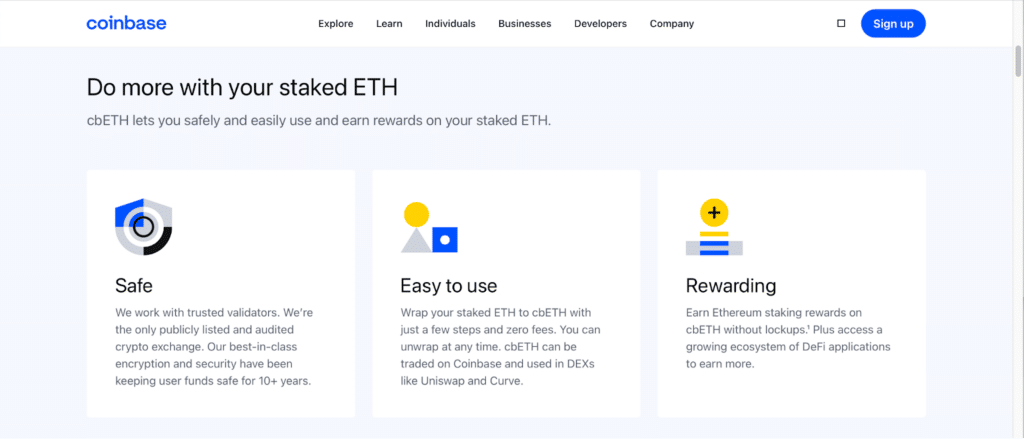Discover what is cbETH, how it works, and the benefits and risks of using Coinbase’s wrapped staked ETH token. Learn how cbETH allows you to earn staking rewards on your Ethereum while retaining the flexibility to use your funds.
Summary
We provide an in-depth look at Coinbase Wrapped Staked ETH (cbETH), a utility token that represents staked Ethereum on the Coinbase platform. We explain what cbETH is, how it works, the benefits it offers, and potential risks to consider. We also cover how to wrap your ETH to cbETH on Coinbase and common questions about this unique staking token.
What is cbETH?
cbETH, or Coinbase Wrapped Staked ETH, is an ERC-20 utility token created and maintained by Coinbase. It represents Ethereum that has been staked on the Coinbase platform to earn rewards for supporting the Ethereum network’s transition to proof-of-stake consensus (Ethereum 2.0).
When you stake ETH on Coinbase, you receive cbETH in return at a 1:1 ratio based on the current ETH to cbETH conversion rate. cbETH represents both your staked ETH principal and any staking rewards accrued over time. The conversion rate between ETH and cbETH will gradually increase as the underlying staked ETH earns rewards.
The key benefit of cbETH is that it provides liquidity and flexibility for your staked ETH. With regular ETH staking, your funds are locked up until Ethereum 2.0 fully launches. But with cbETH, you can sell, transfer, or use the token in DeFi protocols while still earning staking rewards on your underlying ETH. It’s a way to have the best of both worlds – the rewards of staking and the utility of liquid tokens.

How cbETH Works
Under the hood, cbETH is minted by Coinbase when users stake ETH through the platform. The price of cbETH on the open market reflects the value of the underlying staked ETH plus the accumulated staking rewards. As more rewards are generated over time, each cbETH token will be redeemable for an increasing amount of regular ETH.
It’s important to note that cbETH itself does not earn rewards directly. The rewards are actually earned by the staked ETH that backs the token supply. But by holding cbETH, you gain exposure to those growing staking rewards.
Another key aspect is that cbETH can be used outside the Coinbase platform. You can withdraw cbETH to a personal Ethereum wallet and use it in various DeFi applications to potentially generate additional yield on top of the base ETH staking rewards. Popular DeFi protocols like Curve, Convex, and AAVE support cbETH.

Benefits and Risks
The main benefits of cbETH include:
- Earn ETH staking rewards while keeping your funds liquid and usable
- Avoid lockup periods by gaining the ability to sell or transfer your staked ETH
- Maintain exposure to ETH staking yield even if you move your tokens off the Coinbase platform
- Potentially amplify returns by supplying cbETH to other DeFi protocols

However, there are also risks to weigh:
- cbETH price can fluctuate and may trade at a discount to the redemption value of the underlying staked ETH
- Smart contract risks associated with cbETH and any DeFi protocols you supply it to
- Lack of clarity on tax treatment for cbETH transactions in many jurisdictions
- cbETH redemptions for regular ETH will only be available after future Ethereum network upgrades
How to Get cbETH
To obtain cbETH, you must first stake ETH on the Coinbase platform. You can stake any amount of ETH, with no minimum. Once you stake, Coinbase will wrap your staked ETH and provide you with cbETH tokens at the current conversion rate.
If you already have ETH on Coinbase, it’s a simple process:
- Navigate to your ETH asset page and select “Stake”
- Choose the amount of ETH you want to stake
- Confirm the transaction
- The equivalent amount of cbETH will appear in your account based on the conversion rate
You can then choose to hold your cbETH on Coinbase, sell it, or withdraw it to an external Ethereum wallet for use in DeFi.
Conclusion
cbETH is an innovative token that gives ETH stakers a way to retain liquidity and flexibility while still earning network rewards. By wrapping staked ETH into a tradable token, Coinbase has made it easier for more users to participate in securing Ethereum 2.0 without completely locking their funds. Just be aware of the risks and understand that cbETH’s price and utility ultimately depend on the successful development of Ethereum’s consensus upgrade.
We recommend reading these related articles to learn more about other cryptocurrency topics:
FAQs
Is cbETH safe?
cbETH is only as safe as the underlying smart contracts and the Coinbase platform. While Coinbase is a reputable company, it’s important to understand that cbETH represents a claim on staked ETH and is not equivalent to regular ETH itself.
Can I earn rewards by holding cbETH?
Holding cbETH does not earn rewards directly, but the value of cbETH is expected to appreciate over time relative to ETH as the staked ETH it represents accrues rewards. You can potentially earn additional yield by supplying cbETH to DeFi protocols.
Is cbETH taxed like regular ETH?
The tax treatment of cbETH transactions is still unclear in many jurisdictions. Wrapping and unwrapping ETH to cbETH may or may not be a taxable event. Selling cbETH is generally considered a taxable crypto-to-crypto trade. Consult a tax professional for guidance.




